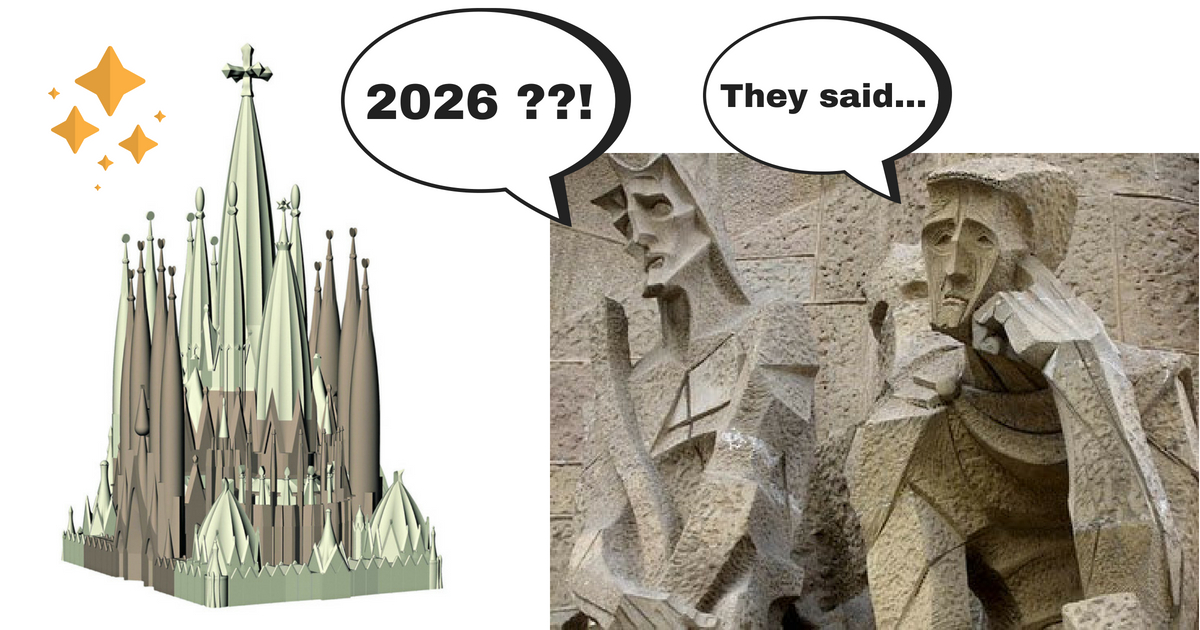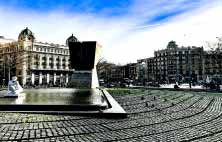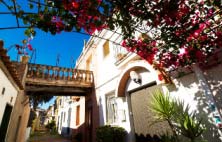Gaudí’s opinion about the completion of the Sagrada Familia
In 1922, a Congress of Architects took place in Barcelona, where Gaudí was asked when the temple would be completed. His response was:
“My client isn’t in a hurry”
Gaudí was a profound Catholic man and considered his client to be God. As they weren’t in a rush to finish it, the first thing to be constructed was the school for the children of the workers. It is a humble brick building with geometrical shapes which amazed Le Corbusier and can be visited today.
“The straight line belongs to Man; the curved line belongs to God” (Antoni Gaudí)
Why is it taking so long to finish the Sagrada Familia?
Finishing the Sagrada Familia is a long and complicated task. The reasons for the delay in the finalisation of the project are its complicated architecture and historical changes such as the death of Gaudí, the Spanish Civil War, the destruction of the original project and the limited economic support from private donations that have subsidised it.
The photo collage shows the evolution of the work over the years. We highlight: the laying of the first stone (1882), the arrival of the first towers at the height of 66 metres tall (1913), the death of Gaudí (1926), the completion of the four bell towers on the façade of the nativity (1933), the consecration of the Sagrada Familia by the pope (2010) and the completion of the Sagrada Familia (2026).
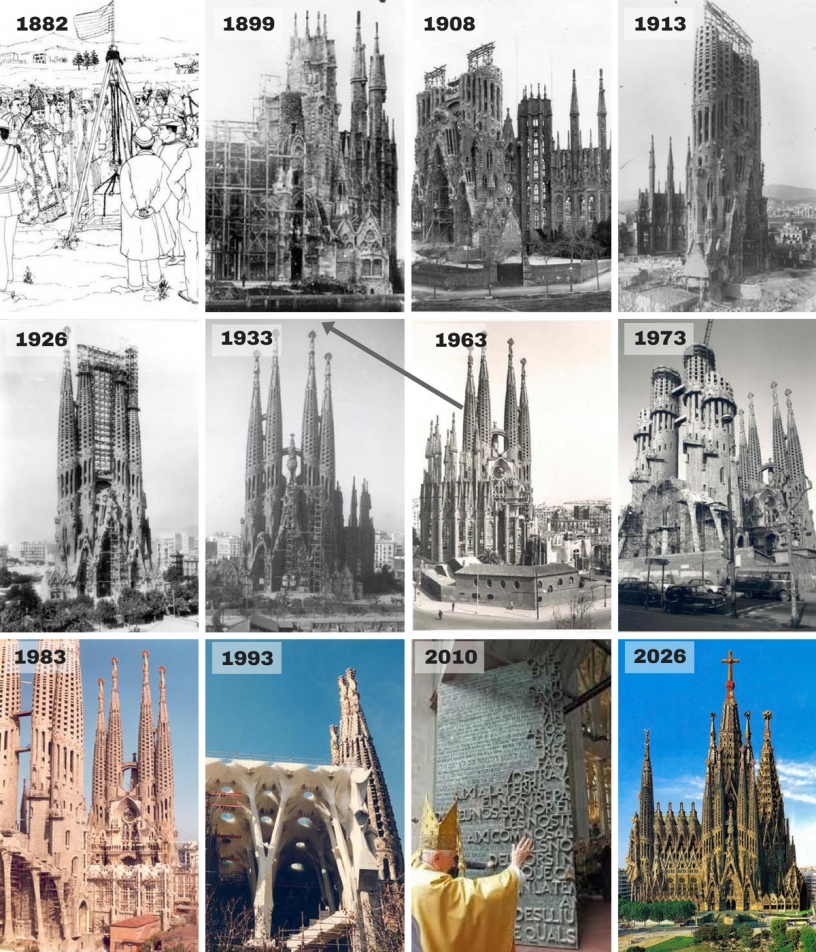
If you come to visit Barcelona, we advise you to stay in an apartment near the Sagrada Familia. In this way, you will save and gain in comfort compared to hotels.
The complexity of the Gaudí designs
The Gaudí project was not mediocre in form or magnitude. The Sagrada Familia will be the highest church in the world when the central Jesus tower reaches 172.5 metres high. Currently, the highest church in the world can be found in Ulm (Germany) and is 161.53 metres tall.
Gaudí was the creator of new architecture based on curved lines. The architecture before Gaudí was based on circles, triangles, squares and rectangles. The genius observed that these simple geometric shapes are rarely found in nature and she fins effective structures endorsed by the history of the centuries.
“My ideas are of an indisputable logic, the only thing that makes me doubt is that they have not been applied previously.” (Antoni Gaudí)
Nobody has done the columns of the Sagrada Familia before. They are columns that are transformed from the base and are built to reach the sky. Thanks to this, the interior of the temple has a structure similar to a forest. Gaudí considered that this environment is what allows the human being to feel closer to God.
-
 Gaudí, from architecture to Catalanism Discover the Catalan architect's love and compromise for his land through his works.
Gaudí, from architecture to Catalanism Discover the Catalan architect's love and compromise for his land through his works.
The death of the Genius (1926)
In 1892, the construction of the nativity façade began. In 1911, the architect designed the façade of the Passion, in 1925 the first bell tower was finished but… Gaudí did not see the finished Facade of the Birth of the Sagrada Familia.
On 10 June 1926, three days after having been hit by a tram after crossing Bailén street at the top of the Gran Vía, the brilliant architect died at 73 years old. Gaudí was heading to the church of Sant Felip Neri to visit his confessor when he was the victim of the tragic accident. He was undocumented and due to his careless appearance several passers-by and drivers mistook him for a beggar and did not come to his aid.
Barcelona excursions
To make the most of Barcelona and fill your trip with unforgettable experiences and emotions, we offer you the excursions through the Catalan capital organized by the GetYourGuide team.
Antoni Gaudí fought for his ideals, died as a poor man, was buried as a king and has gone down in history as one of the great masters of modern architecture.
TIP: Gaudí is buried in the crypt of the Sagrada Familia, in the place where he had worked forty-three years of his life, the last twelve exclusively.
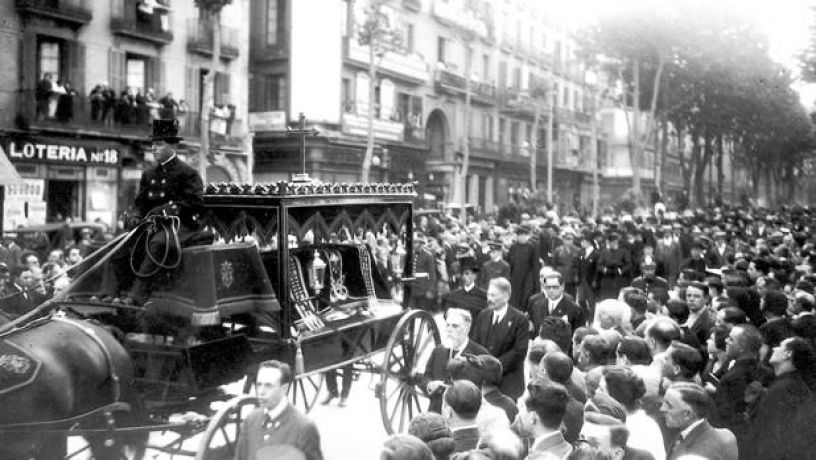
The Civil War and the lost project (1936)
This is the main factor that has prevented the Sagrada Familia from being finished previously.
The anarchists set fire to part of the Sagrada Familia at the beginning of the Spanish Civil War, including the workshop where Gaudí had always worked.
In Gaudí’s workshop there was not a large library and the graphic material was reduced to a minimum. There was a photographic workshop, a space for sculptures, a large area for plaster models (scale 1:10 or 1:25) and a large number of models to investigate aspects of lighting, functionality, construction and structure.
Many of the sketches, drawings and models by the great architect disappeared and a lot of information on how to continue the work was lost. In 1936 they tried to preserve the remains of the destruction by sandwiching the pieces, and that is how they survived the conflict, hidden between two walls.
The Civil War caused the paralysis of the works for 17 years (1935 - 1952). It was not until 1976 that the four towers of the Passion façade were finished, where Josep Maria Subirachs added his sculptural work which begun in 1988.
Missing Budget
The Sagrada Familia is an expiatory temple which means that it is financed only by selfless donations from the loyal supporters and by the tickets of the tourists who visit it.
After the Civil War there was very little money and the little that was available was dedicated to the restoration of the models to recover the project. It was almost an archaeological work that was carried out by the disciples of Gaudí who dedicated themselves to look for pieces and coincidences to try to reproduce the original models.
The last financing crisis was in the middle of the eighties and since that decade, revenues grew exponentially thanks to the increase in tourism. The funds raised by the tickets are dedicated directly to the financing of the works directed by the Foundation of the Construction Board of the Sagrada Familia, created in 1895.
Why is the construction work accelerating now?
The recent acceleration in the pace of the work allows us to hope that the Sagrada Familia will be finished in 2026. This is possible due to two main factors: the great funding generated by the entries and the computer and architectural innovations that have been applied.
Revenue from tickets
In 2017, the Sagrada Familia was the most visited monument in Spain, having received more than 4.5 million visitors. To know the true magnitude of the temple, it is necessary to compare the data: 80% of the tourists who go to the Sagrada Familia only admire it from outside, according to a study by the Barcelona City Council. That is to say, the basilica would have attracted more than 20 million people in its vicinity during that year.
We can say that in 2017 the race began to finish the Sagrada Familia. That year the budget for the construction of the temple was 40 million euros, the largest in history and doubled the budgets of previous years that were around 20 - 25 million euros.
-
 Sagrada Familia Tickets This article gives a clear overview of the different Sagrada Familia Tickets and corresponding ...
Sagrada Familia Tickets This article gives a clear overview of the different Sagrada Familia Tickets and corresponding ...
IT innovations
Three generations of architects have dedicated themselves to recomposing the more than 1,000 pieces of model left over from the fire of Gaudí's studio in 1936. But Gaudí's work was so avant-garde, that architects could not easily reconstruct their designs.
The forms that make up the building are so complex that five different computer programs have had to be combined to reconstruct the surfaces outlined by Gaudí. These programs are used in the automotive and aeronautical industry. This is without a doubt an important factor in the completion of the Sagrada Familia.
Architectural innovations
3D Printers and Virtual Reality
Gaudí transformed his plans into large scale models because he wanted to see the three dimensions.
Since 2000, his model has been continued thanks to the use of 3D printers. These allow us to manufacture the gypsum models originally designed by Gaudí. It is indisputable that 3D vision has helped guide decisions about the design and structural behaviour of the project.
Since the end of 2016, the technology offered by virtual reality glasses has been used to carry out three-dimensional simulations. This technology allows us to reduce the work times in projection.
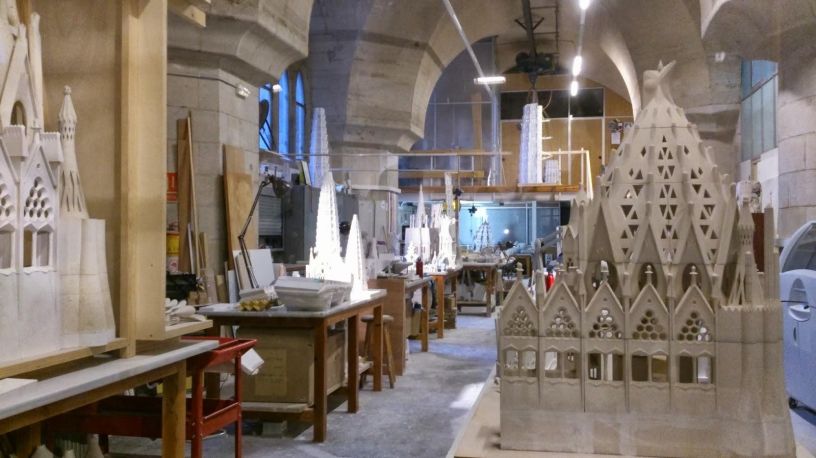
Tensioned stone technique
The Sagrada Familia will have a total of eighteen towers. In 2018, only eight have been completed and the six central towers are being built: that of Jesus Christ, that of the Virgin Mary and of the four evangelists.
The towers are built with stone panels that serve both as a decorative and structural material. These panels have been developed with the innovative technique of tensioned stone.
The tensioning technique is based on drilling the pieces of stone with circular holes to be able to introduce metal bars of stainless steel. In this way a group of about fifteen to twenty pieces are grouped and tensed forming a panel.
This technique greatly accelerates the construction time since the panels:
- Comes manufactured to the Sagrada Familia and saves the task of carrying out a reinforced concrete structure that would have to be covered with decorative stone in the same work.
- Can be placed in block one after another in a single crane operation.
In the following video, discover how towers are being built with these panels.
What will not be finished on the Sagrada Familia in 2026?
The completion date for the Sagrada Familia has been postponed several times. Some people say that they have been more interested in keeping it unfinished until now because of the attractiveness of a slow but constant change.
The artistic part will not be finished
In March 2017 the journalist Antoni Bassas interviewed the current architect director of the Sagrada Familia (Jordi Faulí) and asked him if he could assure that the Sagrada Familia would end in 2026. His answer was:
Yes, as long as the pace of construction can be maintained as it is now. We build based on the contributions of the people. If the number of visitors decreased, we would have a problem. We'll see, what God wants. The important thing is to build with quality, which is what we try to do.
The director does not commit to the completion of the artistic part, although he assures that they are working with a team of theologians. Think that in 2026 there will surely be sculptures and symbols to be made.
The main entrance, will it be finished?
The Construction Board of the Sagrada Familia is an ecclesiastical foundation created in 1895 and whose objective is the administration of the budgets and the fulfillment of the construction project of the Basilica.
This Foundation only has power over the site of its property that in the year 1895 belonged to the old municipality of Sant Martí de Provençals, which was annexed to Barcelona in 1897.
The site of the Sagrada Familia has functioned as an "independent republic" for many years and in 2018 the Temple still has no building license. It has always been built without the municipal inspectors having reviewed the work.
The work to be done outside the site are the responsibility of the Barcelona City Council, which does not have a clear plan on how to complete access to the main façade. This access implies the construction of a stairway above Mallorca street, the demolition of several buildings and the relocation of hundreds of people.
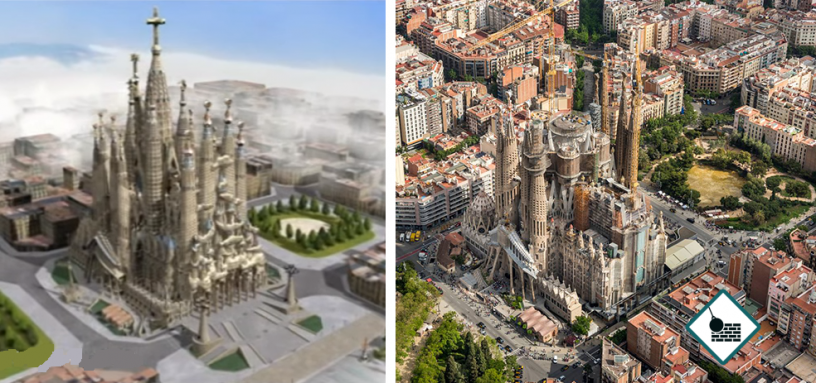
The City Council of 2018 says that the urban issue that affects access to the façade of La Gloria is not a priority. Meanwhile, yes, they have decided to put order to the construction and its construction license.
The municipal consistory is sensitive to the problems of mass tourism in the neighbourhood and consider that it is the Construction Board who must take the initiative and move the piece if it is interested in making the stairway.
The relations between the temple and the different municipal consistories have varied depending on their political colour. The problem is that the consistories last four years, and when the change takes place, the new government disregards what the previous one decided.
Video of the finished Sagrada Familia
Travel to the future with this video in virtual reality and see how the Sagrada Familia ends. It is an official video of the Temple Construction Board.

